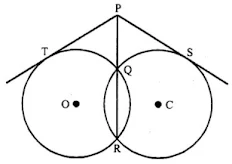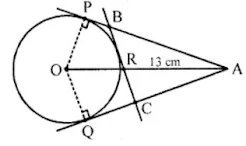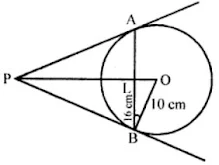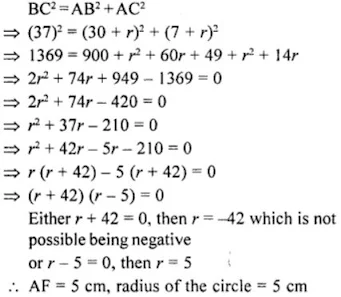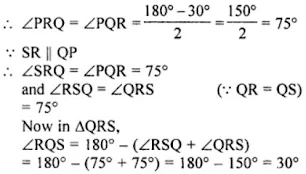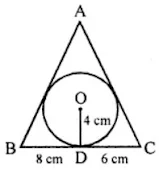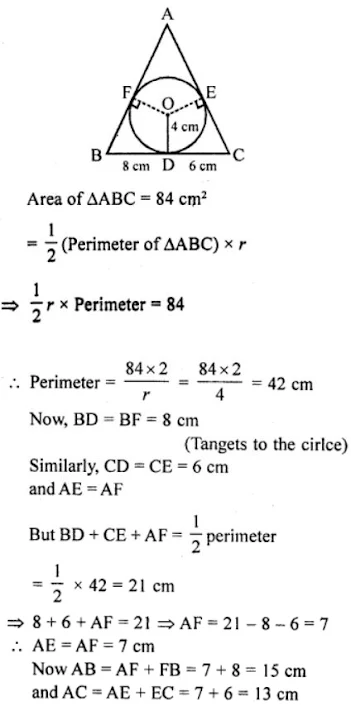RD Sharma Solutions Chapter 10 Circles Exercise 10.2 Class 10 Maths

Chapter Name | RD Sharma Chapter 10 Circles |
Book Name | RD Sharma Mathematics for Class 10 |
Other Exercises |
|
Related Study | NCERT Solutions for Class 10 Maths |
Exercise 10.2 Solutions
1. If PT is a tangent at T to a circle whose centre is O and OP = 17 cm, OT = 8 cm. Find the length of the tangent segment PT.
Solution
PT is the tangent to the circle with centre O, at T.
Radius OT = 8 cm, OP = 17 cm
PT is the tangent segment
Now in right ∆OPT,
OP² = OT² + PT² (Pythagoras Theorem)
⇒ (17)² = (8)² + PT²
⇒ 289 = 64 + PT²
⇒ PT² = 289 – 64 = 225 = (15)²
⇒ PT = 15 cm
2. Find the length of a tangent drawn to a circle with radius 5 cm, from a point 13 cm from the centre of the circle.
Solution
From a point P outside the circle with centre O, PT is the tangent to the circle and radius.
OT = 5 cm, OP = 15 cm
OT ⊥ PT
Now in right ∆OPT,
OP² = OT² + PT² (Pythagoras Theorem)
(13)² = (5)² + PT²
⇒ 169 = 25 + PT²
⇒ PT² = 169 – 25 = 144 = (12)²
⇒ PT = 12 cm
3. A point P is 26 cm away from the centre O of a circle and the length PT of the tangent drawn from P to the circle is 10 cm. Find the radius of the circle.
Solution
From a point P outside the circle of centre 0 and radius OT, PT is the tangent to the circle.
OP = 26 cm, PT = 10 cm
Now in right ∆OPT
Let r be the radius
OP² = OT² + PT² (Pythagoras Theorem)
⇒ (26)² = r² + (10)²
⇒ 676 = r² + 100
⇒ 676 – 100 = r²
⇒ r² = 576 = (24)²
⇒ r = 24
Hence, radius of the circle = 24 cm
4. If from any point on the common chord of two intersecting circles, tangents be drawn to the circles, prove that they are equal.
Solution
Given : QR is the common chord of two circles intersecting each other at Q and R
P is a point on RQ when produced From PT and RS are the tangents drawn to tire circles with centres O and C respectively.
To prove : PT = PS
Proof: PT is the tangent and PQR is the secant to the circle with centre O.
PT² = PQ × PR …(i)
Similarly, PS is the tangent and PQR is the secant to the circle with centre C.
PS² = PQ × PR …(ii)
From (i) and (ii)
PT² = PS²
⇒ PT = PS
Hence, proved.
5. If the sides of a quadrilateral touch a circle, prove that the sum of a pair of opposite sides is equal to the sum of the other pair.
Solution
Given: The sides of a quadrilateral ABCD touch the circle at P, Q, R and S respectively.

To prove : AB + CD = AP + BC
Proof : AP and AS are the tangents to the circle from A
AP = AS …(i)
Similarly,
BP = BQ ...(ii)
CR = CQ …(iii)
and DR = DS …(iv)
Adding, we get
AP + BP + CR + DR = AS + BQ + CQ + DS
⇒ (AP + BP) + (CR + DR) = (AS + DS) + (BQ + CQ)
Hence, proved.
6. Out of the two concentric circles, the radius of the outer circle is 5 cm and the chord AC of length 8 cm is a tangent to the inner circle. Find the radius of the inner circle.
Solution
Let C1 and C2 be the two circles having same centre O. AC is a chord which touches the C1 at point D.|
Join OD.
Also, OD ⊥ AC
AD = DC = 4 cm
[perpendicular line OD bisects the chord]
In right angled ∆AOD,
OA² = AD² + DO²
[by Pythagoras theorem, i.e., (hypotenuse)² = (base)² + (perpendicular)²]
⇒ DO² = 5² – 4² = 25 – 16 = 9
⇒ DO = 3 cm
Radius of the inner circle OD = 3 cm
7. A chord PQ of a circle is parallel to the tangent drawn at a point R of the circle. Prove that R bisects the arc PRQ.
Solution
Given : Chord PQ is parallel tangent at R.
To prove : R bisects the arc PRQ.
Proof: ∠1 = ∠2 [alternate interior angles]
∠1 = ∠3
[angle between tangent and chord is equal to angle made by chord in alternate segment]
∠2 = ∠3
⇒ PR = QR
[sides opposite to equal angles are equal]
⇒ PR = QR
So, R bisects PQ.
8. Prove that a diameter AB of a circle bisects all those chords which are parallel to the tangent at the point A.
Solution
Given, AB is a diameter of the circle.
A tangent is drawn from point A.
Draw a chord CD parallel to the tangent MAN.
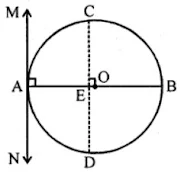
So, CD is a chord of the circle and OA is a radius of the circle.
∠MAO = 90°
[Tangent at any point of a circle is perpendicular to the radius through the point of contact]
∠CEO = ∠MAO [corresponding angles]
⇒ ∠CEO = 90°
Thus, OE bisects CD
[perpendicular from centre of circle to chord bisects the chord]
Similarly, the diameter AB bisects all. Chord which are parallel to the tangent at the point A.
9. If AB, AC, PQ are the tangents in the figure, and AB = 5 cm, find the perimeter of ∆APQ.

Solution
Given : AB, AC and PQ are the tangents to the circle as shown in the figure above and AB = 5 cm
To find : The perimeter of ∆APQ
Proof: PB and PX are the tangents to the circle
PB = PX
Similarly QC and QX are the tangents from
QC = QX
and AB and AC are the tangents from A
AB = AC
Now perimeter of ∆APQ
= AP + PQ + AQ
= AP + PX + QX + AQ
= AP + PB + QC + AQ [PB = PX and QC = QX]
= AB + AC
= AB + AB [AB=AC]
= 2 AB = 2×5 = 10 cm
10. Prove that the intercept of a tangent between two parallel tangents to a circle subtends a right angle at the centre.
Solution
Given : PQ and RS are parallel tangents of a circle.
RMP is the intercept of the tangent between PQ and RS.
RO and PQ are joined.

11. In the figure, PQ is tangent at a point R of the circle with centre O. If ∠TRQ = 30°, find m ∠PRS
Solution
In the figure,
PRQ is tangent to the circle with centre O at R.
RT and RS are joined such that ∠TRQ = 30°
Let ∠PRS = x°
Now ∠SRX = 90° (angle in a semicircle)
But ∠TRQ + ∠SRT + ∠PRS = 180° (Angles of a line)
⇒ 30° + 90° + x° = 180°
⇒ 120° + x° = 180°
⇒ x° = 180° – 120° = 60°
∠PRS = 60°
12. If PA and PB are tangents from an outside point P, such that PA = 10 cm and ∠APB = 60°. Find the length of chord AB.
Solution
PA and PB are the tangents from a point PQ outside the circle with centre O
PA = 10 cm and ∠APB = 60°.
Tangents drawn from a point outside the circle are equal
PA = PB = 10 cm ∠PAB = ∠PBA
(Angles opposite to equal sides)
But in ∆APB,
∠APB + ∠PAB + ∠PBA = 180° (Angles of a triangle)
⇒ 60° + ∠PAB + ∠PAB = 180°
⇒ 2 ∠PAB = 180° – 60° = 120°
⇒ ∠PAB = 60°
⇒ ∠PBA = ∠PAB = 60°
PA = PB = AB = 10 cm
Hence, length of chord AB = 10 cm
13. In a right triangle ABC in which ∠B = 90°, a circle is drawn with AB as diameter intersecting the hypotenuse AC at P. Prove that the tangent to the circle at P bisects BC.
Solution
Let O be the centre of the given circle. Suppose, the tangent at P meets BC at Q.
Join BP.
To prove : BQ = QC
[angles in alternate segment]
Proof : ∠ABC = 90°
[tangent at any point of circle is perpendicular to radius through the point of contact]
In ∆ABC, ∠1 + ∠5 = 90°
[angle sum property, ∠ABC = 90°]
∠3 = ∠1
[angle between tangent and the chord equals angle made by the chord in alternate segment]
∠3 + ∠5 = 90° …(i)
Also, ∠APB = 90° [angle in semi-circle]
∠3 + ∠4 = 90° …(ii)
[∠APB + ∠BPC = 180°, linear pair]
From Eqs. (i) and (ii), we get
∠3 + ∠5 = ∠3 + ∠4
∠5 = ∠4
⇒ PQ = QC
[sides opposite to equal angles are equal]
Also, QP = QB
[tangents drawn from an internal point to a circle are equal]
⇒ QB = QC
Hence, proved.
14. From an external point P, tangents PA and PB are drawn to a circle with centre O. If CD is the tangent to the circle at a point E and PA = 14 cm, find the perimeter of ∆PCD.
Solution
PA and PB are the tangents drawn from a point P out side the circle with centre O.
CD is another tangents to the circle at point E which intersects PA and PB at C and D respectively.
PA = 14 cm
PA and PB are the tangents to the circle from P
PA = PB = 14 cm
Now CA and CE are the tangents from C
CA = CE …(i)
Similarly DB and DE are the tangents from D
DB = DE …(ii)
Now perimeter of ∆PCD
= PC + PD + CD
= PC + PD + CE + DE
= PC + CE + PD + DE
= PC + CA + PD = DB [From (i) and (ii)]
= PA + PB
= 14 + 14
= 28 cm
15. In the figure, ABC is a right triangle right-angled at B such that BC = 6 cm and AB = 8 cm. Find the radius of its incircle.
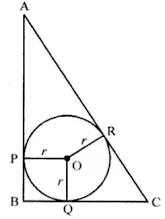
Solution
In right ∆ABC, ∠B = 90°
BC = 6 cm, AB = 8 cm
Let r be the radius of incircle whose centre is O and touches the sides A B, BC and CA at P, Q and R respectively
AP and AR are the tangents to the circle AP = AR
Similarly CR = CQ and BQ = BP
OP and OQ are radii of the circle
OP ⊥ AB and OQ ⊥ BC and ∠B = 90° (given)
BPOQ is a square
BP = BQ = r
AR = AP = AB – BD = 8 – r
and CR = CQ = BC – BQ = 6 – r
But AC² = AB² + BC² (Pythagoras Theorem)
= (8)² + (6)² = 64 + 36 = 100 = (10)²
AC = 10 cm
⇒ AR + CR = 10
⇒ 8 – r + 6 – r = 10
⇒ 14 – 2r = 10
⇒ 2r = 14 – 10 = 4
⇒ r = 2
Radius of the incircle = 2 cm
16. Prove that the tangent drawn at the mid-point of an arc of a circle is parallel to the chord joining the end points of the arc.
Solution
Let mid-point of an arc AMB be M and TMT’ be the tangent to the circle.
Join AB, AM and MB.
Since, arc AM = arc MB
⇒ Chord AM = Chord MB
In ∆AMB, AM = MB
⇒ ∠MAB = ∠MBA …(i)
[equal sides corresponding to the equal angle]
Since, TMT’ is a tangent line.
∠AMT = ∠MBA
[angle in alternate segment are equal]
∠AMT = ∠MAB [from Eq. (i)]
But ∠AMT and ∠MAB are alternate angles, which is possible only when AB || TMT’
Hence, the tangent drawn at the mid-point of an arc of a circle is parallel to the chord joining the end points of the arc.
Hence proved
17. From a point P, two tangents PA and PB are drawn to a circle with centre O. If OP = diameter of the circle show that ∆APB is equilateral.
Solution
Given : From a point P outside the circle with centre O, PA and PB are the tangents to the circle such that OP is diameter.
AB is joined.
To prove: APB is an equilateral triangle
Const : Join OP, AQ, OA
Proof : OP = 2r
⇒ OQ + QP = 2r
⇒ OQ = QP = r (OQ = r)
Now in right ∆OAP,
OP is its hypotenuse and Q is its mid point
OA = AQ = OQ
(mid-point of hypotenuse of a right triangle is equidistance from its vertices)
∆OAQ is equilateral triangle ∠AOQ = 60°
Now in right ∆OAP,
∠APO = 90° – 60° = 30°
⇒ ∠APB = 2 ∠APO = 2 x 30° = 60°
But PA = PB (Tangents from P to the circle)
⇒ ∠PAB = ∠PBA = 60°
Hence ∆APB is an equilateral triangle.
18. Two tangents segments PA and PB are drawn to a circle with centre O such that ∠APB = 120°. Prove that OP = 2 AP.
Solution
Given : From a point P. Out side the circle with centre O, PA and PB are tangents drawn and ∠APB = 120°
OP is joined To prove : OP = 2 AP
Const: Take mid point M of OP and join AM, join also OA and OB.
Proof : In right ∆OAP,
∠OPA = 1/2 ∠APB = 1/2 ×120° = 60°
∠AOP = 90° – 60° = 30°
M is mid point of hypotenuse OP of ∆OAP
MO = MA = MP
∠OAM = ∠AOM = 30° and ∠PAM = 90° – 30° = 60°
∆AMP is an equilateral triangle
MA = MP = AP
But M is mid point of OP
OP = 2 MP = 2 AP
Hence proved.
19. If ∆ABC is isosceles with AB = AC and C (0, r) is the incircle of the ∆ABC touching BC at L. Prove that L bisects BC.
Solution
Given: In ∆ABC, AB = AC and a circle with centre O and radius r touches the side BC of ∆ABC at L.
To prove : L is mid point of BC.
Proof : AM and AN are the tangents to the circle from A
AM = AN
But AB = AC (given)
AB – AN = AC – AM
BN = CM
Now BL and BN are the tangents from B
BL = BN
Similarly CL and CM are tangents
CL = CM
But BM = CM (proved)
BL = CL
L is mid point of BC.
20. AB is a diameter and AC is a chord of a circle with centre O such that ∠BAC = 30°. The tangent at C intersects AB at a point D. Prove that BC = BD.
Solution
To prove, BC = BD
Join BC and OC.
Given, ∠BAC = 30°
⇒ ∠BCD = 30°
[angle between tangent and chord is equal to angle made by chord in the alternate segment]
∠ACD = ∠ACO + ∠OCD
∠ACD = 30° + 90° = 120°
[OC ⊥ CD and OA = OC = radius ⇒ ∠OAC = ∠OCA = 30°]
In ∆ACD,
∠CAD + ∠ACD + ∠ADC = 180°
[Since, sum of all interior angles of a triangle is 180°]
⇒ 30° + 120° + ∠ADC = 180°
⇒ ∠ADC = 180° – (30° + 120°) = 30°
Now, in ∆BCD,
∠BCD = ∠BDC = 30°
⇒ BC = BD
[since, sides opposite to equal angles are equal]
21. In the figure, a circle touches all the four sides of a quadrilateral ABCD with AB = 6 cm, BC = 7 cm, and CD = 4 cm. Find AD.
Solution
A circle touches the sides AB, BC, CD and DA of a quadrilateral ABCD at P, Q, R and S respectively.
AB = 6 cm, BC = 7 cm, CD = 4cm
Let AD = x
AP and AS are the tangents to the circle
AP = AS
Similarly,
BP = BQ
CQ = CR
and OR = DS
AB + CD = AD + BC
⇒ 6 + 4 = 7 + x
⇒ 10 = 7 + x
⇒ x = 10 – 7 = 3
AD = 3 cm
22. Prove that the perpendicular at the point contact to the tangent to a circle passes through the centre of the circle.
Solution
Given : TS is a tangent to the circle with centre O at P, OP is joined.
To prove : OP is perpendicular to TS which passes through the centre of the circle
Construction : Draw a line OR which intersect the circle at Q and meets the tangent TS at R
Proof: OP = OQ (radii of the same circle)
and OQ < OR ⇒ OP < OR
Similarly we can prove that OP is less than all lines which can be drawn from O to TS
OP is the shortest
OP is perpendicular to TS
Perpendicular through P, will pass through the centre of the circle
Hence proved.
23. Two circles touch externally at a point P. From a point T on the tangent at P, tangents TQ and TR are drawn to the circles with points of contact Q and R respectively. Prove that TQ = TR.

Solution
Given : Two circles with centres O and C touch each other externally at P. PT is its common tangent
From a point T on PT, TR and TQ are the tangents drawn to the circles.
To prove : TQ = TR
Proof : From T, TR and TP are two tangents to the circle with centre O
TR = TP …(i)
Similarly, from T,
TQ and TP are two tangents to the circle with centre C
TQ = TP …(ii)
From (i) and (ii)
TQ = TR
Hence proved.
24. A is a point at a distance 13 cm from the centre O of a circle of radius 5 cm. AP and AQ are the tangents to the circle at P and Q. If a tangent BC is drawn at a point R lying on the minor arc PQ to intersect AP at B and AQ at C, find the perimeter of the ∆ABC.
Solution
Given : Two tangents are drawn from an external point A to the circle with centre O, Tangent BC is drawn at a point R, radius of circle equals to 5 cm.
To find : Perimeter of ∆ABC.
Proof : ∠OPA = 90°
[Tangent at any point of a circle is perpendicular to the radius through the point of contact]
OA² = OP² + PA² [by Pythagoras Theorem]
(13)² = 5² + PA²
⇒ PA² = 144 = 12²
⇒ PA = 12 cm
Now, perimeter of ∆ABC = AB + BC + CA = (AB + BR) + (RC + CA)
= AB + BP + CQ + CA [BR = BP, RC = CQ tangents from internal point to a circle are equal]
= AP + AQ = 2AP = 2 x (12) = 24 cm
[AP = AQ tangent from internal point to a circle are equal]
Hence, the perimeter of ∆ABC = 24 cm.
25. In the figure, a circle is inscribed in a quadrilateral ABCD in which ∠B = 90°. If AD = 23 cm, AB = 29 cm and DS = 5 cm, find the radius r of the circle.

Solution
In the figure, O is the centre of the circle inscribed in a quadrilateral ABCD and ∠B = 90°
AD = 23 cm, AB = 29 cm, DS = 5 cm
OP = OQ (radii of the same circle)
AB and BC are tangents to the circle and OP and OQ are radii
OP ⊥ BC and OQ ⊥ AB
∠OPB = ∠OQB = 90°
PBQO is a square
DS and DR are tangents to the circle
DR = DS = 5 cm
AR = AD – DR = 23 – 5 = 18 cm
AR and AQ are the tangents to the circle
AQ = AR = 18 cm But AB = 29 cm
BQ = AB – AQ = 29 – 18 = 11 cm
Side of square PBQO is 11 cm
OP = 11 cm
Hence, radius of the circle = 11 cm
26. In the figure, there are two concentric circles with centre O of radii 5 cm and 3 cm. From an external point P, tangents PA and PB are drawn to these circles. If AP =12 cm, find the length of BP.

Solution
Two concentric circles with centre O with radii 5 cm and 3 cm respectively from a point P, PA and BP are tangents drawn to there circles.
AP = 12 cm
To find BP
In right ∆OAP,
OP² = OA² + AP² (Pythagoras Theorem)
= (5)² + (12)² = 25 + 144
= 169 = (13)²
OP = 13 cm
Now in right ∆OBP,
OP² = OB² + BP²
⇒ (13)² = (3)² + BP²
⇒ 169 = 9 + BP²
⇒ BP² = 169 – 9 = 160 = 16×10
BP = √(16×10) = 4√10 cm
27. In the figure, AB is a chord of length 16 cm of a circle of radius 10 cm. The tangents at A and B intersect at a point P. Find the length of PA.
Solution
In the figure, AB is the chord of the circle with centre O and radius 10 cm.
Two tangents from P are drawn to the circle touching it at A and B respectively
AB is joined with intersects OP at L
In right triangle OBP,
28. In the figure, PA and PB are tangents from an external point P to a circle with centre O. LN touches the circle at M. Prove that PL + LM = PN + MN.
Solution
Given : In the figure, PA and PB are the tangents to the circle with centre O from a point P outside it LN touches it at M.
To prove : PL + LM = PN + MN
Prove : PA and PB are tangents to the circle from P
PA = PB
Similarly from L, LA and LM are tangents
LA = LM
Similarly NB = NM
Now PA = PB => PL + LA = PN + NB
PL + LM = PN + NM
Hence, proved.
29. In the figure, BDC is a tangent to the given circle at point D such that BD = 30 to the circle and meet when produced at A making BAC a right angle triangle. Calculate (i) AF (ii) radius of the circle.
Solution
In the figure, BDC is a tangent to the given circle with centre O and D is a point such that,
BD = 30 cm and CD = 7 cm
BE and CF are other two tangents drawn from B and C respectively which meet at A on producing this and ∆BAC is a right angle so formed
To find : (i) AF and (ii) radius of the circle
Join OE and OF
OE = OF radii of the circle
OE ⊥ AB and OF ⊥ AC
OEAF is a square
BD and BE are the tangents from B
BE = BD = 30 cm and similarly
CF = CD = 7 cm
Let r be the radius of the circle
OF = AF = AE = r
AB = 30 + r and AC = 7 + r and BC = 30 + 7 = 37 cm
Now in right ∆ABC,
30. If d1, d2 (d2 > d1) be the diameters of two concentric circles and c be the length of a chord of a circle which is tangent to the other circle, prove that d22 = c2 + d12.
Solution
Let AB be a chord of a circle which touches the other circle at C. Then ∆OCB is right triangle.
31. In the given figure, tangents PQ and PR are drawn from an external point P to a circle with centre O, such that ∠RPQ = 30°. A chord RS is drawn parallel to the tangent PQ. Find ∠RQS.
Solution
In the given figure,
PQ and PR are tangents to the circle with centre O drawn from P
∠RPQ = 30°
Chord RS || PQ is drawn
To find ∠RQS
PQ = PR (tangents to the circle)
∠PRQ = ∠PQR But ∠RPQ = 30°
32. From an external point P, tangents PA = PB are drawn to a circle with centre O. If ∠PAB = 50°, then find ∠AOB.
Solution

PA = PB [tangents drawn from external point are equal]
∠PBA = ∠PAB = 50° [angles equal to opposite sides]
∠APB = 180° – 50° – 50° = 80° [angle-sum property of a triangle]
In cyclic quad. OAPB,
∠AOB + ∠APB = 180° [sum of opposite angles of a cyclic quadrilateral is 180°]
⇒ ∠AOB + 80° = 180°
⇒ ∠AOB = 180°- 80° = 100°
33. In the figure, two tangents AB and AC are drawn to a circle with centre O such that ∠BAC = 120°. Prove that OA = 2AB.

Solution
Given : In the figure, O is the centre of the circle.
AB and AC are the tangents to the circle from A such that
∠BAC = 120°.
To prove : OA = 2AB
Proof : In ∆OAB and ∆OAC
∠OBA = ∠OCA – 90° (OB and OC are radii)
OA = OA (common)
OB = OC (radii of the circle)
∆OAB ~ ∆OAC
⇒ ∠OAB = ∠OAC = 60°
Now in right ∆OAB,
34. The lengths of three consecutive sides of a quadrilateral circumscribing a circle are 4 cm, 5 cm, and 7 cm respectively. Determine the length of the fourth side.
Solution
In quadrilateral ABCD which is circumscribing the circle,
BC = 4 cm, CD = 5 cm and DA = 7 cm
We know that if a quad, is circumscribed in a circle, then
AB + CD = AD + BC
⇒ AB + 5 = 4 + 7
⇒ AB + 5 = 11
AB = 11 – 5 = 6
AB = 6 cm
35. The common tangents AB and CD to two circles with centres O and O’ intersect at E between their centres. Prove that the points O, E and O’ are collinear.
Solution
Construction: Join AO, OC and O’D, O’B
In △OAE & △OCE, we have
OA = OC [radii of the same circle]
OE = OE [common side]
∠OAE = ∠OCE
△OAE ≅ △OCE [RHS congruence criterion]
∠AEO=∠CEO [By CPCT]
Similarly,
∠BEO′ = ∠DEO′
∠AEC = ∠DEB
1/2∠AEC = 1/2∠DEB
⇒ ∠AEO = ∠CEO = ∠BEO′ = ∠DEO′
Since, these angles are equal and are bisected by OE & O'E,
O, E, O′ are collinear.
36. In the figure, common tangents PQ and RS to two circles intersect at A. Prove that PQ = RS.
Solution
Given : Two common tangents PQ and RS intersect each other at A.
To Prove : PQ = RS
Proof: From A, AQ and AR are two tangents are drawn to the circle with centre O.
AP = AR …(i)
Similarly, AQ and AS are the tangents to the circle with centre C
AQ = AS …(ii)
Adding (i) and (ii)
AP + AQ = AR + AS
⇒ PQ = RS
Hence, proved.
37. Two concentric circles are of diameters 30 cm and 18 cm. Find the length of the chord of the larger circle which touches the smaller circle.
Solution
Let R be the radius of outer circle and r be the radius if small circle of two concentric circle.
AB is the chord of the outer circle and touches the smaller circle at P.
Join OP, OA.
38. AB and CD are common tangents to two circles of equal radii. Prove that AB = CD.
Solution
Given : AB and CD are tangents to two circles of equal radii.
To prove :
Construction : Join OA, OC, O’B and O’D
Proof: Now, ∠OAB = 90°
[tangent at any point of a circle is perpendicular to radius through the point of contact]
Thus, AC is a straight line.
Also,
∠OAB + ∠OCD = 180°
AB || CD
Similarly, BD is a straight line and ∠O’BA = ∠O’DC = 90°
Also, AC = BD [diameters of two circles are equal]
In quadrilateral ABCD,
∠A = ∠B = ∠C = ∠D = 90°
and AC = BD [opposite sides of rectangle are equal]
ABCD is a rectangle
Hence, AB = CD
39. A triangle PQR is drawn to circumscribe a circle of radius 8 cm such that the segments QT and TR, into which QR is divided by the point of contact T, are of lengths 14 cm and 16 cm respectively. If area of ∆PQR is 336 cm², find the sides PQ and PR.
Solution
∆PQR is circumscribed by a circle with centre O and radius 8 cm.
T is point of contact which divides the line segment OT into two parts such that
QT = 14 cm and TR = 16 cm
Area of ∆PQR = 336 cm²
Let PS = x cm
QT and QS are tangents to the circle from Q
QS = QT = 14 cm
Similarly RU and RT are tangents to the circle
RT = RU = 16 cm
Similarly PS and PU are tangents from P
PS = PU = x
Now, PQ = x + 14 and PR = x + 16 and QR = 14 + 16 = 30 cm
Now, area of ∆PQR = Area of ∆POQ + area of ∆QOR + area of ∆POR
40. In the figure, the tangent at a point C of a circle and a diameter AB when extended itersect at P. If ∠PCA = 110°, find ∠CBA.
Solution
Here, AB is a diameter of the circle from point C and a tangent is drawn which meets at a point P.
Join OC. Here, OC is radius.
Since, tangent at any point of a circle is perpendicular to the radius through point of contact circle.
OC ⊥ PC
Now, ∠PCA = 110° [given]
⇒ ∠PCO + ∠OCA = 110°
⇒ 90° + ∠OCA = 110°
⇒ ∠OCA = 20°
OC = OA = Radius of circle
∠OCA = ∠OAC = 20° [since, two sides are equal, then their opposite angles are equal]
Since, PC is a tangent, so
∠BCP = ∠CAB = 20° [angles in a alternate segment are equal]
In ∆PBC, ∠P + ∠C + ∠A= 180°
∠P = 180° – (∠C + ∠A)
⇒ ∠P = 180° – (110° + 20°)
⇒ ∠P = 180° – 130° = 50°
In ∆PBC,
∠BPC + ∠PCB + ∠PBC = 180° [sum of all interior angles of any triangle is 180°]
⇒ 50° + 20° + ∠PBC = 180°
⇒ ∠PBC = 180° – 70°
⇒ ∠PBC = 110°
Since, ∆PB is a straight line.
∠PBC + ∠CBA = 180°
⇒ ∠CBA = 180° – 110° = 70°
41. AB is a chord of a circle with centre O, AOC is a diameter and AT is the tangent at A as shown in the figure. Prove that ∠BAT = ∠ACB.
Solution
Since, AC is a diameter line, so angle in semicircle makes an angle 90°.
∠ABC = 90° [by property]
In ∆ABC,
∠CAB + ∠ABC + ∠ACB = 180° [sum of all interior angles of any triangle is 180°]
⇒ ∠CAB + ∠ACB = 180° – 90° = 90° …(i)
Since, diameter of a circle is perpendicular to the tangent.
i.e. CA ⊥ AT
∠CAT = 90°
⇒ ∠CAB + ∠BAT = 90° …(ii)
From Eqs. (i) and (ii),
∠CAB + ∠ACB = ∠CAB + ∠BAT
⇒ ∠ACB = ∠BAT
Hence, proved.
42. In the given figure, a ∆ABC is drawn to circumscribe a circle of radius 4 cm such that the segments BD and DC are of lengths 8 cm and 6 cm respectively. Find the lengths of sides AB and AC, when area of ∆ABC is 84 cm².
Solution
In the given figure,
In ∆ABC is circle is inscribed touching it at D, E and F respectively.
Radius of the circle (r) = 4cm
OD ⊥ BC, then
OD = 4 cm, BD = 8 cm, DC = 6 cm
Join OE and OF
43. In the given figure, AB is a diameter of a circle with centre O and AT is a tangent. If ∠AOQ = 58°, find ∠ATQ.
Solution
In the given figure,
AB is the diameter, AT is the tangent
and ∠AOQ = 58°
To find ∠ATQ.
Arc AQ subtends ∠AOQ at the centre and ∠ABQ at the remaining part of the circle
∠ABQ = 1/2∠AOQ = 1/2 ×58° = 29°
Now in ∆ABT,
∠BAT = 90° (OA ⊥ AT)
∠ABT + ∠ATB = 90°
⇒ ∠ABT + ∠ATQ = 90°
⇒ 29° + ∠ATQ = 90°
⇒ ∠ATQ = 90°- 29° = 61°
44. In the figure, OQ : PQ = 3:4 and perimeter of ∆POQ = 60 cm. Determine PQ, QR and OP.
Solution
In the figure, OQ : PQ = 3:4
Perimeter of ∆POQ = 60 cm
To find PQ, QR and OP
OQ : PQ = 3 : 4
Let OQ = 3x and PQ = 4x
Now in right ∆OPQ,
OP² = OQ² + PQ² = (3x)² + (4x)² = 9x² + 16x² = 25x² = (5x)²
⇒ OP = 5x
But OQ + QP + OP = 60 cm
3x + 4x + 5x = 60
⇒ 12x = 60
⇒ x = 5
PQ = 4x = 4 x 5 = 20 cm
QR = 2 OQ = 2 × 3x = 6×5 = 30 cm
OP = 5x = 5×5 = 25 cm
45. Equal circles with centre O and O’ touch each other at X. OO’ produced to meet a circle with centre O’, at A. AC is a tangent to the circle whose centre is O. O’ D is perpendicular to AC. Find the value of DO′/CO.
Solution
Two equal circles with centre O and O’ touch each other externally at X.
OO’ produced to meet at A.
AC is the tangent of circle with centre O,
O’D ⊥ AC is drawn OC is joined
AC is tangent and OC is the radius
OC ⊥ AC
O’D ⊥ AC
OC || O’D
Now,
O’A = 1/2 A x or 1/2 AO
Now in O’AD and AOAC,
∠A = ∠A (common)
⇒ ∠AO’D = ∠AOC (corresponding angles)

46. In the figure, BC is a tangent to the circle with centre O. OE bisects AP. Prove that ∆AEO ~ ∆ABC.
Solution
Given : In the figure, BC is a tangent to the circle with centre O at B.
AB is diameter AC is joined which intersects the circle at P.
OE bisects AP.
To prove : ∆AEO ~ ∆ABC
Proof: In ∆OAE and ∆OPE
OE = OE (common)
OA = OP ‘ (radii of the same circle)
EA = EP (given)
∆OAE = ∆OPE (SSS axiom)
∠OEA = ∠OEP
But ∠OEA + ∠OEP = 180°
⇒ ∠OEA = 90°
Now in ∆AEO and ∆ABC,
∠OEA = ∠ABC (each 90°)
∠A = ∠A (common)
∆AEO ~ ∆ABC (AA axiom)
Hence proved.
47. In the figure, PO ⊥ QO. The tangents to the circle at P and Q intersect at a point T. Prove that PQ and OT are right bisectors of each other.
Solution
Given : In the figure, O is the centre of the circle.
PO ⊥ QO
They tangents at P and Q intersect each other at T.
To prove : PQ and OT are right bisector of each other.
Proof : PT and QT are tangents to the circle.
PT = QT
OP and OQ are radii of the circle and ∠POQ = 90°. (PO ⊥ QO)
OQTP is a square Where PQ and OT are diagonals.
Diagonals of a square bisect each other at right angles.
PQ and OT bisect each other at right angles.
Hence, PQ and QT are right bisectors of each other..
48. In the figure, O is the centre of the circle and BCD is tangent to it at C. Prove that ∠BAC + ∠ACD = 90°.
Solution
Given : In the figure, O is the centre of the circle BCD is a tangent, CP is a chord.
To Prove : ∠BAC + ∠ACD = 90°
Proof: ∠ACD = ∠CPA (Angles in the alternate segment)
But in ∆ACP,
∠ACP = 90° (Angle in a semicircle)
∠PAC + ∠CPA = 90°
⇒ ∠BAC + ∠ACD = 90° (∠ACD = ∠CPA proved)
Hence, proved.
49. Prove that the centre of a circle touching two intersecting lines lies on the angle bisector of the lines.
Solution
Given : Two tangents PQ and PR are drawn from an external point P to a circle with centre O.
To prove : Centre of a circle touching two intersecting lines lies on the angle bisector of the lines.
Construction : Join OR, and OQ.
In ∆POR and ∆POQ
∠PRO = ∠PQO = 90°
[tangent at any point of a circle is perpendicular to the radius through the point of contact]
OR = OQ [radii of same circle]
Since, OP is common.
∆PRO = ∆PQO [RHS]
Hence, ∠RPO = ∠QPO [by CPCT]
Thus, O lies on angle bisector of PR and PQ.
Hence proved.
50. In the figure, there are two concentric circles with centre O. PRT and PQS are tangents to the inner circle from a point P lying on the outer circle. If PR = 5 cm, find the lengths of PS.
Solution
Construction : Join OS and OP.
Consider ∆POS
We have,
PO = OS
∆POS is an isosceles triangle.
We know that in an isosceles triangle, if a line drawn perpendicular to the base of the triangle from the common vertex of the equal sides, then that line will bisect the base (unequal side).
And PQ = PR = 5 cm
[PRT and PQS are tangents to the inner circle to the inner circle from a point P lying on the outer circle]
We have, PQ = QS
It is given that, PQ = 5 cm
QS = 5 cm
From the figure, we have
PS = PQ + QS
⇒ PS = 5 + 5
⇒ PS = 10 cm
51. In the figure, PQ is a tangent from an external point P to a circle with centre O and OP cuts the circle at T and QOP is a diameter. If ∠POR = 130° and S is a point on the circle, find ∠1 + ∠2.
Solution
Construction : Join RT.
Given, ∠POR = 130°
∠POQ = 180°- (∠POR) = 180° – 130° = 50°
Since, PQ is a tangent
∠PQO = 90°
Now, In ∆POQ,
∠POQ + ∠PQO + ∠QPO = 180°
⇒ 50° + 90° + ∠1 = 180°
⇒ ∠1 = 180° – 140°
⇒ ∠1 = 40°
Now in ∆RST,
∠RST = 12 ∠ROT
[Angle which is subtended by on arc at the centre of a circle is double the size of the angle subtended at any point on the circumference]
⇒ ∠2 = 12×130° = 65°
Now, ∠1 + ∠2 = 40° + 65° = 105°
52. In the figure, PA and PB are tangents to the circle from an external point P. CD is another tangent touching the circle at Q. If PA = 12 cm, QC = QD = 3 cm, then find PC = PD.
Solution
PA = PB = 12 cm …(i)
QC = AC = 3cm …(ii)
QD = BD = 3 cm …(iii)
[Tangents drawn from an external point are equal]
To find : PC + PD
= (PA – AC) + (PB – BD)
= (12 – 3) + (12 – 3) [From (i), (ii), and (iii)]
= 9 + 9 = 18 cm




